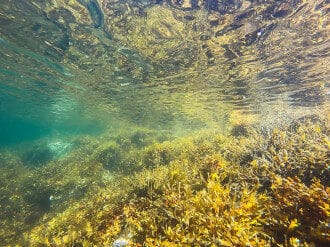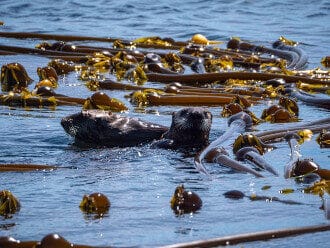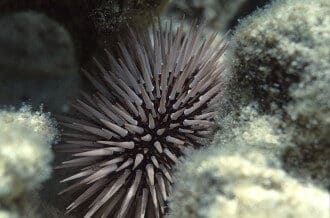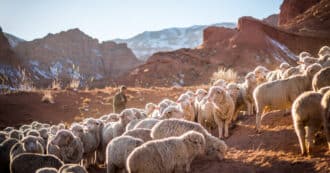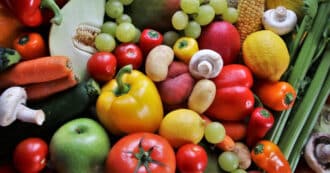By Harry Cooper – When most people think of biodiverse ocean ecosystems, they usually think of vibrant coral reefs in tropical waters. But there are many other unique types of ocean ecosystems that are home to numerous species, such as a kelp forest.
Kelp Ecosystems
Kelp forest ecosystems are made up of dense plumes of of giant kelp that provide food and shelter to a variety of marine animals. These forests can be found throughout the world in cold nutrient rich water.
These kelp forests are not only stunningly beautiful and biologically diverse, but they also provide various environmental and human benefits. But as human activity continues to encroach on these forests, the integrity of kelp forest ecosystems around the world are being threatened.
Issues such as overfishing and climate change have disrupted the ecological balance of several major kelp forest communities. However, environmental movements and conservation efforts have been working hard to ensure that the kelp forests don’t die out.
What Makes a Kelp Forest Special?
One of the most unique features about kelp forests is that they are not actually made up of plants. Kelp is actually an excessively large species of brown algae.
Kelp Biology
Because kelp is a type of algae there are many different things it needs to survive that are different from plants. This allows kelp forests to pop up in very specific spots.
Kelp LifeCyle
Unlike marine plants, kelp species release spores rather than seeds in order to reproduce. These spores then must find a shallow rocky area of coast line in order to grow into large pillars of kelp.
In order to grow to their famously tall heights, kelp must secure themselves in the rocks with root-like structures known as holdfasts. While these structures resemble roots, they do not take in any nutrients; instead kelp get all their nutrients by filter feeding the water around them.
This is why it is incredibly important for kelp to not only grow in shallow rocky areas, but also in places with cold nutrient rich waters. While kelp habitat is very specific, if the right conditions are met, kelp flourishes.
In fact, kelp can be capable of growing up to 30.5 cm a day. This means that kelp can be fully grown in around three months, and can live up to seven years.
Kelp Forest Ecosystem
Once fully grown, a kelp forest also provides a habitat for a variety of marine life. The kelp not only serves as a food source for numerous herbivores, but they also act as an excellent home for animals to hide and hunt in.
Biodiversity in the Kelp Forest
Kelp forests are some of the most biodiverse and productive ecosystems in the world. The kelp forests provide food and serve as a home for species such as bass, rock fish, sunfish, sea otters, sea lions, whales, sea birds, sea urchins, sea stars, and many other animals and marine life.
These kelp forest species each fill specific biological niches in the food web. This helps make for an elaborate and healthy kelp forest community.
Kelp Forests and Ecosystem Services
In addition to holding a wide variety of life, kelp forests also provide numerous ecosystem services. This makes them not only an important part of nature, but also valuable to humans as wells.
Kelp Tourism and Recreation
The serene beauty of the kelp forests attract people from all over the world to swim, kayak, scuba dive, and explore the underwater forests. This is incredibly important for coastal tourism industries all around the world.
In addition to directly drawing in tourism, kelp forests act as a wave break. This prevents erosion along beaches and keeps them sandy and pleasant for tourists and beach goers.
Kelp Carbon Sequestration
While kelp is a type of algae, not a plant, it still photosynthesizes and takes carbon dioxide out of the water around it and replaces it with oxygen. Because kelp grows at such an astonishing rate, it makes kelp forests incredibly efficient at sequestering carbon.
As humans continue to put massive amounts of climate change causing greenhouse gases into the air, the more important it becomes to sequester carbon and store it away. The easiest way to do this is to plants and algae to naturally take in carbon.
While most people think of trees as the best way to store carbon, many forests are prone to disruption and deforestation, and often grow slowly. Coastal ecosystems, on the other hand, grow incredibly fast, and are 20 times more efficient at storing away carbon than terrestrial forests.
On top of that, most kelp gets taken by currents out into the deep ocean. This makes it very hard for the carbon stored in the kelp to ever be disturbed and put back into the atmosphere.
Fishing Industries
Kelp forests are an important habitat for commercial fish species such as bass and rockfish. By providing a place for these fish to live and eat, kelp forests are critical for commercial and recreational fishing industries.
As important as the kelp forests are for fishing industries, in many parts of the world the fishing industries themselves are becoming a serious problem. Overfishing, as well as some other issues, are putting kelp forests at risk of disappearing.
Threats to Kelp Forests
Due to human involvement, kelp forests are beginning to face a chain reaction of affects that could cause a total collapse of their ecosystem. While overfishing removes vital species from the ecosystem that help feed top predators, and keep sea urchins and other primary consumers in check, kelp forests face another daunting threat: climate change.
Kelp Forest Collapse
One of the most important factors in the kelp lifecycle is having enough nutrients in the water to be able to rapidly grow so tall. These nutrients come primarily from a process of cold deep ocean currents bring nutrients to the shallow coasts called upwelling.
Upwelling is usually a predictable annual process, but as the the Earth’s climate is changing, coastal communities are seeing more and more heat spells. Kelp is normally adapted to withstand heat spells, but as climate change makes the heat spells more intense and frequent, they are starting to inhibit the annual upwelling, and leaving kelp forests with insufficient nutrients.
On top of that, in some parts of the world the warmer waters are also causing disruptions in the kelp ecosystems themselves. This can be seen in the southern California kelp forests where heat waves have killed off large amounts of sea stars, a natural predator of sea urchins.
These urchins eat kelp, and usually keep the forest in check. However with less natural predators, the urchins are capable of feeding on kelp unchecked, turning massive areas of kelp forest into barren ocean floor, known as urchin barrens.
Repairing Kelp Forests
Kelp forests have started disappearing in many places around the world. However, conservation efforts have proved to be fairly successful at repairing kelp ecosystems.
One of the most important things being done to combat kelp forest decline is manually removing sea urchins in lieu of the natural predators such as sea stars and sea otters that usually keep their populations in check. This has shown to help remove urchin barrens and allow for kelp forests to be reestablished in treated areas.
While these conservation efforts have been able to bring back some kelp forests, overall kelp forests are still in danger of being pushed out. Even with urchin removal, it is still not a permanent solution to the broader issues of climate change and overfishing.
Religion and Kelp
Soli Salgado writes for Global Sisters Report about how the St. Joseph Sisters of Brentwood, New York are teaming up with the Shinnecock Indian Nation. Recently “one of the Shinnecock leaders contacted (Sister Joan) Gallagher in January 2021 about accessing the congregation’s waters in Hampton Bays so they could launch a kelp farming project” and Gallagher and her fellows nuns were eager to help. Gallagher explained, “How can we not? They walked this land before our coming here.”
The kelp that is being grown is sold to farmers as fertilizer, and has the added benefit that it “will help purify the bay and attract shellfish for the tribe to eat.” It’s wonderful to see how Christians and Native Americans can work together, not just with each other, but also with nature and local farmers.
As Gallagher commented, “If those farmers can then use this kelp that was grown in the Shinnecock Bay and harvested by the Shinnecock farmers, it’s just a beautiful relationship.” It is our hope and prayer at the Interfaith Center for Sustainable Development to see many more beautiful relationships grow between people of different religions. The fate of humanity and our planet depends on them.
* Featured image source


